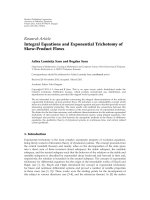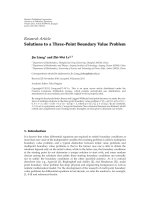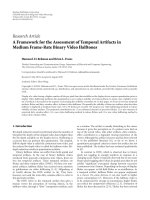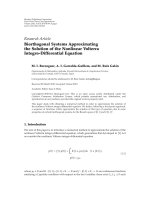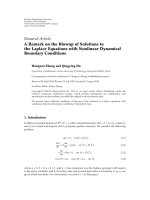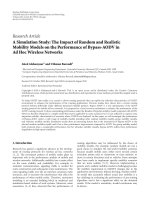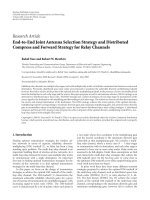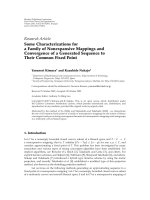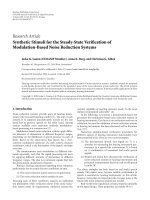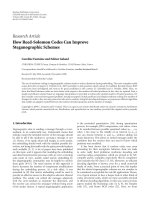Báo cáo hóa học: " Research Article How to Solve the Problem of Bad Performance of Cooperative Protocols at Low SNR Charlotte Hucher, Ghaya Rekaya-Ben Othman, and Jean-Claude Belfiore" potx
Bạn đang xem bản rút gọn của tài liệu. Xem và tải ngay bản đầy đủ của tài liệu tại đây (804.16 KB, 7 trang )
Hindawi Publishing Corporation
EURASIP Journal on Advances in Signal Processing
Volume 2008, Article ID 243153, 7 pages
doi:10.1155/2008/243153
Research Article
How to Solve the Problem of Bad Performance of
Cooperative Protocols at Low SNR
Charlotte Hucher, Ghaya Rekaya-Ben Othman, and Jean-Claude Belfiore
Ecole Nationale Superieure des Telecommunications, 46 rue Barrault, 75013 Paris Cedex 13, France
Correspondence should be addressed to Charlotte Hucher,
Received 1 June 2007; Accepted 27 August 2007
Recommended by Ranjan K. Mallik
We propose some new adaptive amplify-and-forward (AF) and decode-and-forward (DF) protocols using a selection. The new
selection criterion is a function of the instantaneous capacities of all possible transmission schemes (with or without cooperation).
Outage probabilities and simulation results show that the adaptive cooperation protocols solve the problem of bad performance
of cooperation protocols at low SNR. Moreover, they improve the asymptotic performance of their corresponding AF and DF
protocols.
Copyright © 2008 Charlotte Hucher et al. This is an open access article distributed under the Creative Commons Attribution
License, which permits unrestricted use, distribution, and reproduction in any medium, provided the original work is properly
cited.
1. INTRODUCTION
Diversity techniques have been developed in order to com-
bat fading on wireless channels and improve the reliability
of the received message. Recently, cooperation has been pro-
posed as a new mean to obtain “space-time” or “coopera-
tive” diversity [1, 2]. Different nodes in the network coop-
erate in order to form a virtual MIMO system and exploit
space-time diversity even if their hardware constraints do not
allow them to support several antennas. Many cooperative
protocols have been proposed [3–6] which can be classified
in three main families: amplify-and-forward (AF), decode-
and-forward (DF), and compress-and-forward (CF).
In this paper we are interested in the two first families,
which are the more natural ones. AF protocols have been
studied the most due to their simplicity. Indeed, the relays
just amplify the received signals and forward them. DF pro-
tocols require a bit more processing: this strategy consists in
decoding the received signals at the relays and then forward-
ing them. They have interesting performance, however, and
are even essential for multihop systems. Asymptotically, both
protocols bring diversity and give better performance than
SISO which only uses the direct link. However, it does not
match noncooperation at low SNR.
We propose here a new strategy named adaptive cooper-
ation which can be applied either to AF or to DF protocols.
This new strategy consists in choosing the best transmission
scheme, based on a new selection criterion, a function of
the instantaneous capacities of all these possible transmis-
sion schemes. Selection between cooperation and noncoop-
eration has already been proposed in literature for DF proto-
cols [5, 7], as well as relay selection [8], but never adapted to
AF protocols. Moreover, the usual selection criterion of DF
protocol is based only on the source-relay outage probabil-
ity, while the proposed selection takes all the channel links
into account. Outage probability calculations and simula-
tion results prove that the new adaptive AF and DF protocols
perform asymptotically better than their corresponding AF
and DF protocols, and more interesting, solve the problem
of poor performance of cooperation protocols at low SNR.
2. SYSTEM MODEL
We consider N + 1 terminals who want to transmit messages
to the same destination D. The channel is shared in a TDMA
manner, so each terminal is allocated a different time slot and
the system can be reduced to a relay channel with one source,
N relays, and one destination (Figure 1). The N +1 terminals
play the role of the source in succession while the others are
used as relays.
In the next sections, we will use the notation given in
Figure 1. The channel coefficient of the link between source
2 EURASIP Journal on Advances in Signal Processing
R
1
R
2
R
n
h
1
h
2
h
n
g
2
g
1
g
0
g
n
SD
Figure 1: System model : a relay channel with one source, N relays,
and one destination.
S and destination D is g
0
, the one between source S and relay
R
i
is h
i
, and the one between relay R
i
and destination D is g
i
.
We consider a half-duplex channel; each terminal, and in
particular the relays, cannot receive and transmit at the same
time. The channel links are Rayleigh, slow fading, so we can
consider their coefficients as constant during the transmis-
sion of at least one frame.
We suppose that all terminals are equipped with only one
antenna; the MIMO case is not considered in this work. We
focus here on the protocol. So, for simplicity, we assume a
uniform energy distribution between source and relays, with
the total power kept constant.
We will see in the following (see Sections 3.3 and 6.2) that
channel state information needs to be known only at destina-
tion.
3. NEW SELECTION FOR AF PROTOCOLS
AF protocols proposed in literature [3, 4, 6] bring diversity at
high SNR, but their performance at low SNR is poorer than
that of the noncooperative scheme. To solve this issue, we in-
troduce the adaptive AF strategy where the choice of a trans-
mission scheme is based on the channel links quality.
3.1. Presentation of the adaptive AF
The idea leading to the definition of the adaptive AF strategy
is to consider all possible transmission schemes and decide
which one to select. In order to better understand this strat-
egy, the one-relay case is detailed, before the generalization
to the N-relay case.
One-relay case
There are only three possible transmission schemes as follows
(Figure 2).
(a) AF case: full cooperation scheme is used, symbols are
sent using the AF protocol. In case of a full rate proto-
col (NAF [9]), the symbol rate is 1 symbol per channel
use (1 symb. pcu).
(b) SISO case: only direct link is used, symbols are sent
over the source-destination link in a noncoded man-
ner, at a rate of 1 symb. pcu.
(c) NLOS case: only nonline-of-sight (NLOS) link is used,
in a first phase symbols are sent over the source-relay
link in a noncoded manner and forwarded by the re-
lay in a second phase. The rate is then 1/2symb. pcu.
Therefore in order to have the same spectral efficiency
of 1 symb. pcu case as in the other cases, we need to use
a larger constellation. For example, if the other pro-
tocols use a 16-QAM constellation, the NLOS scheme
must use a 256-QAM.
The principle of this new adaptive AF strategy is to eval-
uate the qualities of the three schemes (SISO, AF, and NLOS)
and to select the best of them.
Generalization to the N-relay case
This selection can be generalized quite easily to a higher
number of relays.
For example, for 2 relays R
1
and R
2
, the number of possi-
ble schemes is 7:
(1) full cooperation: symbols are sent using the AF proto-
col for 2 relays. With a full rate protocol, the symbol
rate is 1 symb. pcu;
(2) cooperation with only relay R
1
: symbols are sent using
the AF protocol for only 1 relay. With a full rate proto-
col, the symbol rate is still 1 symb. pcu;
(3) cooperation with only relay R
2
;
(4) noncooperation: symbols are sent in a noncoded man-
ner over the direct link: the symbol rate is 1 symb. pcu
again;
(5) NLOS link using only relay R
1
:symbolsaresentina
noncoded manner and the symbol rate is 1/2symb.
pcu;
(6) NLOS link using only relay R
2
;
(7) both NLOS links: the symbol rate is 1/2symb.pcu.
The number of cases grows with the number of relays. In
the N-relay case, there are
N
k
=0
N
k
=
2
N
different cooper-
ation cases from the noncooperative one (no relay, k
= 0) to
the full cooperation one (N relays, k
= N). If K>2 terminals
are transmitting simultaneously, the signal power has to be
divided by K, which makes the signals too difficult to decode.
That is why we consider only the NLOS cases with one or two
relays, which corresponds to
N
1
+
N
2
+ N(N +1)/2cases.
We can remark as well that, in cooperation schemes, even if
several relays are used, at each time slot, only two terminals
transmit simultaneously. So finally, there are 2
N
+N(N +1)/2
different transmission schemes to consider.
However, this high number of cases does not increase
complexity that much. Indeed, only a simple test is neces-
sary to determine the best one. As some schemes are iden-
tical except for exchanging coefficients (e.g., NLOS with re-
lay R
1
or relay R
2
), the decoding complexity reduces to only
(N +1)+2
= N +3different algorithms. So the complex-
ity of this new selection protocol increases linearly with the
number of relays, which is quite reasonable.
Charlotte Hucher et al. 3
h
g
1
g
0
SD
R
(a) AF scheme
g
0
SD
R
(b) SISO scheme
h
g
1
SD
R
(c) NLOS scheme
Figure 2: Three possible schemes in the 1-relay case.
Moreover, we will show in the example of Section 4 that
depending on the chosen AF scheme, some cases can be
omitted, which reduces the complexity even more.
3.2. Selection criterion
In the previous subsection we have listed all the 2
N
+ N(N +
1)/2 possible transmission cases. The question is now which
criterion to use to select the best one.
We propose to study all these schemes and to select the
one which has the largest instantaneous capacity.
Let us number the possible transmission schemes from 1
to N
S
= 2
N
+ N(N +1)/2 and note C
i
(H) the instantaneous
capacity of the ith scheme. The selected transmission scheme
is the one offering the maximum instantaneous capacity
arg max
i{1, ,N
s
}
C
i
(H)
(1)
with
C
i
(H) = log
2
1+SNRH
H
H
. (2)
3.3. Implementation constraints
To implement the new adaptive AF strategy, a node in the
network has to decide which transmission scheme to use. We
suppose that this node is the destination. So it has to estimate
the channel coefficient g
0
of the direct link and the product
channels g
i
β
i
h
i
for each relay R
i
, calculate the instantaneous
capacity of each possible transmission scheme, and deter-
mine the one to be used. Then it broadcasts no more than
log
2
(2
N
+ N(N +1)/2)=N + 1 bits at both source and
relays in order to inform them about its decision.
As we consider a slow fading channel, an estimation is
made for several frames and so the transmission strategy re-
mains the same. When a new estimation is made and if the
strategy has to change, it is effective after a delay of one frame
during which the strategy is not optimal.
4. EXAMPLE OF THE ADAPTIVE NAF PROTOCOL
In order to better understand this new selection strategy and
its possible simplifications, we develop in this section the ex-
ample of the adaptive NAF protocol.
Table 1: NAF protocol.
S
x
11
x
12
x
21
x
22
··· x
N1
x
N2
R
1
y
r1
β
1
y
r1
R
2
y
r2
β
2
y
r2
.
.
.
···
.
.
.
R
N
y
rN
β
N
y
rN
D
y
N2
y
N1
y
22
y
21
y
12
y
11
4.1. NAF protocol
We consider the nonorthogonal AF (NAF) protocol pro-
posed in [4] for the one-relay case and generalized in [5]to
N>1relays.
This protocol is schematized in Ta bl e 1 where x
i1
, x
i2
are
the signals to be transmitted, y
ri
is the received signal at the
ith relay, y
i1
,y
i2
are the received signals at destination, and β
i
is the scale factor of the ith relay. The source keeps transmit-
ting: x
11
during the first time slot and x
12
during the second
one, and so on. During the first time slot, the first relay lis-
tens y
r1
, and, during the second time slot, retransmits a scale
version of the signal β
i
y
r1
.
Theoptimumvalueofeachscalefactorβ
i
has been cal-
culated in [9]:
β
i
=
1
√
1+SNR
h
i
2
,(3)
where SNR stands for the signal-to-noise ratio.
An equivalent model of the form Y
= HX+W can be cal-
culated for any number of relays. After vectorization and sep-
aration of real and imaginary parts of complex expressions,
we obtain a lattice representation of the system. So decoding
can be performed by using ML lattice decoders, such as the
sphere decoder or the Schnorr-Euchner algorithm.
Ithasbeenprovenin[9] that this protocol is optimal
when used with the distributed Golden code [10] for the one-
relay case, or a distributed 2N
×2N perfect code [11] for the
N-relay case.
4.2. Adaptive NAF protocol
As can be seen immediately in Ta bl e 1, the NAF scheme is
a parallel protocol. Indeed, the N relays of the NAF scheme
4 EURASIP Journal on Advances in Signal Processing
play exactly the same role and are never used in the same
time. By studying the instantaneous capacities of the coop-
eration schemes using NAF protocol with different number
of relays, we can see easily that the greatest instantaneous ca-
pacity will be associated to a one-relay case.
So we can avoid to study all the NAF strategies with sev-
eral relays, which reduces considerably the complexity. In-
deed, the adaptive NAF protocol is then the result of the se-
lection of the best transmission scheme between the SISO
scheme, the NAF schemes using only one relay, and the
NLOS schemes using either 1 or 2 relays. Finally, we have only
1+N + N(N +1)/2
= (1 + N)(1+N/2) possible transmission
cases to study and 4 corresponding decoding algorithms; and
so, we can remark that the decoding complexity does not in-
crease with the number of relays.
5. PERFORMANCE OF THE ADAPTIVE AF STRATEGY
5.1. Outage probability
The outage probability can be expressed as a function of the
instantaneous capacity. For each scheme numbered from 1
to N
S
= 2
N
+ N(N +1)/2asinSection 3.2:
P
(i)
out
= P
C
i
(H) <R
,(4)
where R is the spectral efficiency in bits per channel use (bits
pcu).
The principle of the adaptive AF protocol is to choose the
transmission scheme that maximizes the instantaneous ca-
pacity C
i
(H)overi. So the instantaneous capacity of the new
adaptive AF protocol is larger than each C
i
(H)forafixed-
channel realization H. Thus, the selection scheme is in out-
age if and only if the N
S
possible transmission schemes are all
in outage. So we get
P
(AAF)
out
≤ P
(i)
out
i ∈
1, , N
S
. (5)
We can calculate and plot the outage probabilities of these
different protocols as functions of the SNR thanks to Monte
Carlo simulations.
In Figure 3, we plot the outage probabilities of the SISO,
NAF, and adaptive NAF protocols for a one-relay scheme and
aspectralefficiency of 4 bits pcu. We can note that the adap-
tive NAF performs better than the NAF protocol. Indeed, we
obtain a 4 dB asymptotic gain. Even more interesting is the
fact that the adaptive NAF always performs better than SISO,
even at low SNR, which was the main weakness of the NAF
protocol without selection.
In Figure 4, we plot the outage probabilities of the SISO,
NAF and adaptive NAF protocols for a two-relay scheme and
aspectralefficiency of 4 bits pcu. Here again, the enhance-
ment of the adaptive NAF over the NAF protocol is verified,
as we obtain a 5 dB asymptotic gain and solve the problem of
bad performance at low SNR.
10
−4
10
−3
10
−2
10
−1
10
0
Outage probability
010203040
SNR (dB)
SISO
NAF
Adaptive NAF
Figure 3: 1-relay scheme: comparison of the outage probabilities of
the noncooperative case, the NAF protocol, and the adaptive NAF
for 4 bits pcu.
10
−4
10
−3
10
−2
10
−1
10
0
Outage probability
010203040
SNR (dB)
SISO
NAF
Adaptive NAF
Figure 4: 2-relay scheme: comparison of the outage probabilities of
the noncooperative case, the NAF protocol, and the adaptive NAF
for 4 bits pcu.
5.2. Simulation results
In Figures 5 and 6, we plot the frame error rate of the SISO,
NAF, and adaptive NAF protocols as functions of the SNR for
aspectralefficiency of 4 bits pcu.
In Figure 5, the curves for a one-relay scheme are repre-
sented. The NAF protocol is implemented with a distributed
Golden code [10] and a Schnorr-Euchner decoding. Simu-
lation results confirm theoretical ones obtained by outage
probability calculations. We can observe that the a3daptive
NAF performs better asymptotically than the NAF protocol,
with a 5 dB gain. Moreover, we can check that it solves the
problem of bad performance at low SNR.
Charlotte Hucher et al. 5
10
−4
10
−3
10
−2
10
−1
10
0
Frame error rate
010203040
SNR (dB)
SISO
NAF
Adaptive NAF
Figure 5: 1-relay scheme: comparison of the performance of the
noncooperative case, the NAF protocol, and the adaptive NAF for
4 bits pcu.
10
−4
10
−3
10
−2
10
−1
10
0
Frame error rate
010203040
SNR (dB)
SISO
NAF
Adaptive NAF
Figure 6: 2-relay scheme: comparison of the performance of the
noncooperative case, the NAF protocol, and the adaptive NAF for
4 bits pcu.
In Figure 6, the curves for the two-relay scheme are repre-
sented. The NAF protocol is implemented with a distributed
4
×4perfectcode[11] and a Schnorr-Euchner decoding. The
improved performances of the adaptive NAF are here again
confirmed with a 7 dB gain over the NAF protocol. Besides,
the problem of bad performance of the NAF at low SNR is
solved with two relays too, since the adaptive NAF curve is
always under the SISO curve.
6. NEW SELECTION FOR DF PROTOCOLS
This new selection working quite efficiently on AF protocols,
we propose to adapt it to DF protocols, which have the same
10
−4
10
−3
10
−2
10
−1
10
0
Outage probability
010203040
SNR (dB)
SISO
Alamouti DF
Adaptiv e Alamouti DF
Figure 7: 1-relay scheme: comparison of the outage probabilities of
the noncooperative case, the Alamouti DF protocol, and the adap-
tive Alamouti DF for 4 bits pcu.
10
−4
10
−3
10
−2
10
−1
10
0
Frame error rate
010203040
SNR (dB)
SISO
Alamouti DF
Adaptiv e Alamouti DF
Figure 8: 1-relay scheme: comparison of the performance of the
noncooperative case, the Alamouti DF protocol, and the adaptive
Alamouti DF for 4 bits pcu.
problem as the AF protocols: poorer performance at low SNR
than SISO.
6.1. Presentation of the adaptive DF
The adaptive DF strategy is based on the same principle than
the adaptive AF strategy. However, relays do not amplify the
signals but decode them for both DF and NLOS protocols.
So there is one more criterion to take into account. Indeed, a
DF or NLOS protocol is efficient only if signals are correctly
decoded at relays.
According to Shannon theorem, if a source-relay link is
in outage, signals cannot be decoded without error at this
6 EURASIP Journal on Advances in Signal Processing
relay. On the contrary, if a source-relay link is not in outage,
detection without error is possible and we can use either a
DF or a NLOS protocol using this relay by assuming that no
error occurs during detection.
So a first selection step has to be added to the protocol.
In the N-relay case, the strategy of an adaptive DF protocol
is as follows:
(1) select only the K relays whose source-relay link is not
in outage,
(2) select the best transmission scheme in the 2
K
+ K(K +
1)/2 possible ones in term of instantaneous capacity.
6.2. Implementation constraints
As in the adaptive AF strategy, it is the destination who has
to select the best transmission scheme. However, before con-
sidering the possible transmission schemes, it has to know
which relays are usable, that is, which source-relay links are
not in outage. We propose that each relay estimates its own
source-relay link and transmits a single bit to the destination
indicating whether it is in outage or not.
Then, the steps are the same as for the adaptive AF:
the destination estimates the direct link g
0
and the relay-
destination links g
i
for all K relays which are not in outage.
Estimations of the source-relay links are not necessary as the
relays decode the signals. Thanks to these estimations, it can
calculate the instantaneous capacities of all possible trans-
mission schemes and determine the best one. N + 1 bits are
then necessary to broadcast the information on the chosen
scheme to the source and relays.
7. EXAMPLE OF THE ADAPTIVE ALAMOUTI
DF PROTOCOL
7.1. Alamouti DF protocol
TheAlamoutiDFprotocolisaDFprotocoldesignedfora
1-relay channel and based on the Alamouti space-time code
[12]. It requires 4 channel uses to send 2 symbols: the symbol
rate is 1/2symb.pcu.
As schematized in Tabl e 2 , in the first phase, the source
sends the first line of the Alamouti codeword: x
1
and x
2
,
while the relay listens. In the second phase, the relay sends
a decoded version of the first line of the codeword, while the
source sends the second line of the Alamouti codeword:
−x
∗
2
and x
∗
1
. The destination keeps listening during the whole
transmission.
Assuming x
1
and x
2
have been correctly decoded, the re-
ceived signals can be written in the form Y
=
√
SNRHX +W
with an equivalent channel matrix H being orthogonal. So,
linear decoding can be performed as for the original Alam-
outi ST code.
However, the Alamouti DF protocol can be used only if
the signals are correctly decoded at the relay, which, accord-
ing to Shannon’s theorem, is possible only if the source-relay
link is not in outage. In the other case, we can not use the re-
lay, so signals are sent in a noncoded manner over the direct
link.
Table 2: Alamouti DF protocol.
S
x
1
x
2
−x
∗
2
x
∗
1
x
1
x
2
R
y
r1
y
r2
D
y
4
y
3
y
2
y
1
7.2. Adaptive A lamouti DF protocol
The first test is on the source-relay link. Two cases can occur:
(1) either it is in outage, then signals cannot be decoded
without error at relay, so we only use the direct link;
(2) or it is not in outage, then three different transmission
schemes can be considered:
(a) SISO scheme;
(b) Alamouti DF scheme;
(c) NLOS scheme.
According to the same selection criterion as in Sec
ure ??, we choose the one with the greatest instantaneous ca-
pacity.
8. PERFORMANCE OF THE ADAPTIVE DF STRATEGY
8.1. Outage probability
The outage probability of the adaptive DF protocols can be
proven to be lower than the outage probability of the cor-
responding DF protocols in the same manner than for the
adaptive AF protocols. It comes directly from the selection
criterion which minimizes the instantaneous capacity.
In Figure 7, we plot the outage probabilities of the SISO,
Alamouti DF, and adaptive Alamouti DF protocols as func-
tions of the SNR, obtained through Monte Carlo simula-
tions. We can see that for the DF protocols too, the new se-
lection criterion brings a great improvement in asymptotic
performance with a 4 dB gain, and solves the problem of bad
performance at low SNR.
8.2. Simulation results
We plot the performance simulations of the SISO, Alamouti
DF, and adaptive Alamouti DF protocols as functions of the
SNR in Figure 8. The improvements due to the new selec-
tion criterion are here again confirmed with a 3 dB asymp-
totic gain, and better or same performance as SISO for low
SNR.
9. CONCLUSION
We proposed adaptive amplify-and-forward (AF) and
decode-and-forward (DF) protocols based on a new selection
criterion derived from the calculations of the instantaneous
capacities of all possible transmission schemes (SISO, coop-
erative schemes, NLOS schemes). For the adaptive DF proto-
col, an additional selection on the source-relay links is nec-
essary to ensure an efficient decoding at relays. Both outage
probability and performance from simulation results prove
Charlotte Hucher et al. 7
that the adaptive cooperation enhances the performance of
the initial cooperation schemes at high SNR, and solves the
problem of poor performance at low SNR.
REFERENCES
[1] A. Sendonaris, E. Erkip, and B. Aazhang, “User cooperation
diversity—part I: system description,” IEEE Transactions on
Communications, vol. 51, no. 11, pp. 1927–1938, 2003.
[2] A. Sendonaris, E. Erkip, and B. Aazhang, “User cooper-
ation diversity—part II: implementation aspects and per-
formance analysis,” IEEE Transactions on Communications,
vol. 51, no. 11, pp. 1939–1948, 2003.
[3] J. Laneman and G. Wornell, “Distributed space-time-coded
protocols for exploiting cooperative diversity in wireless net-
works,” IEEE Transactions on Information Theory, vol. 49,
no. 10, pp. 2415–2425, 2003.
[4] R. Nabar, H. B
¨
olcskei, and F. Kneub
¨
uhler, “Fading relay chan-
nels: performance limits and space-time signal design,” IEEE
Journal on Selected Areas in Communications, vol. 22, no. 6,
pp. 1099–1109, 2004.
[5] K. Azarian, H. El Gamal, and P. Schniter, “On the achiev-
able diversity-multiplexing tradeoff in half-duplex cooperative
channels,” IEEE Transactions on Information Theory, vol. 51,
no. 12, pp. 4152–4172, 2005.
[6] S. Yang and J C. Belfiore, “Towards the optimal amplify-and-
forward cooperative diversity scheme,” IEEE Transactions on
Information Theory, vol. 53, no. 9, pp. 3114–3126, 2007.
[7] J. Laneman, D. Tse, and G. Wornell, “Cooperative diversity
in wireless networks: efficient protocols and outage behavior,”
IEEE Transactions on Information T heory, vol. 50, no. 12, pp.
3062–3080, 2004.
[8]A.S.Ibrahim,A.Sadek,W.Su,andK.J.R.Liu,“SPC12-
5: relay selection in multi-node cooperative communications:
when to cooperate and whom to cooperate with?” in IEEE
Global Telecommunications Conference (GLOBECOM ’06),pp.
1–5, San Francisco, Calif, USA, November-December 2006.
[9] S. Yang and J C. Belfiore, “Optimal space-time codes for the
MIMO amplify-and-forward cooperative channel,” in IEEE
International Zurich Seminar on Digital Communications,pp.
122–125, Zurich, Switzerland, February 2006.
[10] J C. Belfiore, G. Rekaya, and E. Viterbo, “The golden code:
a2
×2 full-rate space-time code with non-vanishing determi-
nants,” IEEE Transactions on Information Theory, vol. 51, no. 4,
pp. 1432–1436, 2005.
[11] F. Oggier, G. Rekaya, J C. Belfiore, and E. Viterbo, “Perfect
space-time block codes,” IEEE Transactions on Information
Theory, vol. 52, no. 9, pp. 3885–3902, 2006.
[12] S. M. Alamouti, “A simple transmit diversity technique for
wireless communications,” IEEE Journal on Selected Areas in
Communications, vol. 16, no. 8, pp. 1451–1458, 1998.
